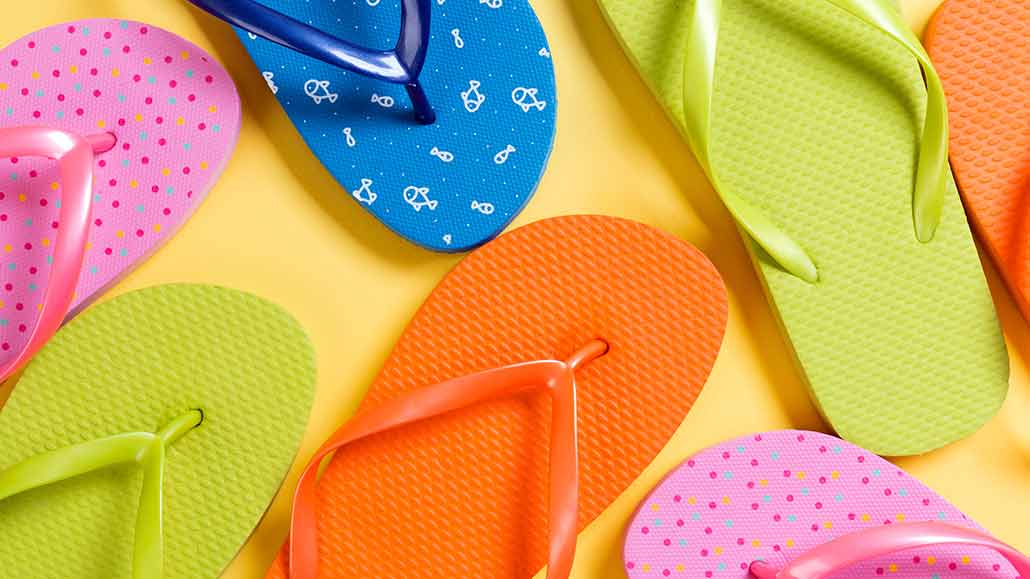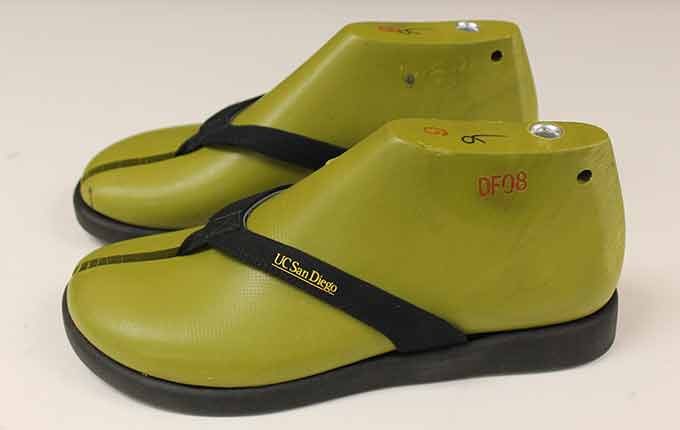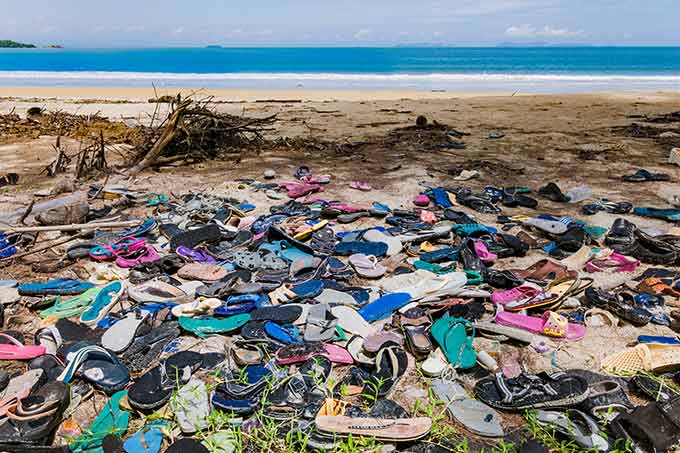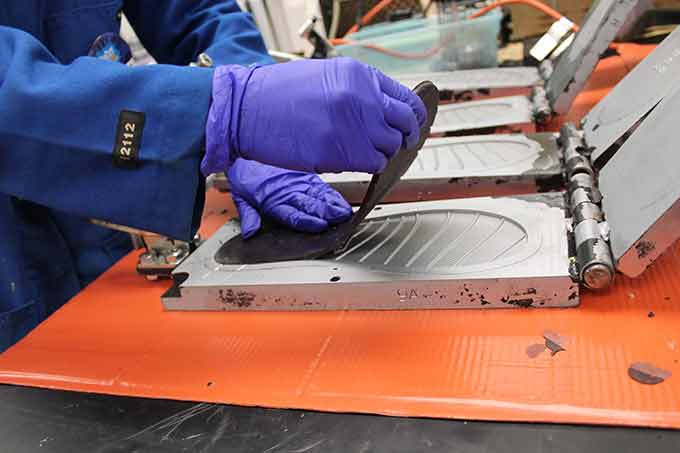Here’s how to make flip-flops biodegradable
Start with an algae-based plastic that microbes can break down

These flip-flops are not biodegradable. But experimental ones made with a algae-based recipe are. And they would offer a host of environmental benefits.
Mykola Sosiukin/iStock/Getty Images Plus
Flip-flops are great shoes for warm weather. But once discarded, they can last many years in landfills before decomposing. Old flip-flops also can break into tiny bits and add to the plastic polluting waters and soils around the world. Now researchers have invented a new type of flip-flop. Made from an algae-based plastic, it’s designed to break down in soil or compost.
“I actually have a pair that I’ve worn for almost a year now. They’re super comfortable,” says Marissa Tessman. She’s a chemist at Algenesis Materials in San Diego, Calif. As a graduate student, she also worked alongside the algal plastic’s developers at the University of California San Diego (UCSD).

Tessman compares different chemical formulas for plastics to recipes for cakes and cookies. By tweaking different ingredients, you can change the properties of the final product. For flip-flops, her group wanted the foam to feel right to the touch and feel comfy underfoot.
But this work all started with surfboards.
Most of those boards have a plastic core made from polyurethane (Pah-lee-YUR-eh-thayn). It’s not biodegradable. And its ingredients come from crude oil or natural gas. Both are fossil fuels. Some years ago, a company asked the UCSD team to develop a greener surfboard, one that would biodegrade and not depend so much on fossil fuels.
Many surfers liked the idea of a greener board, Tessman explains. So the team turned to algae. Algae make lots of oils and other carbon-based chemicals. Those can be used to make compounds called polyols (PAHL-ee-ahls). These have multiple groups of linked hydrogen and oxygen atoms. And they can be used to make one of the ingredients that makes up just more than half of the polyurethane in the new flip-flops.
But one ingredient in the plastic still comes from crude oil. Teams at UCSD and elsewhere are now working to make it from algae, too.
The scientists unveiled a model of their new surfboard in 2015. Part of the team then started the company Algenesis to scale up the process. That board should go on sale soon, Tessman says.
“The chemistry behind a surfboard is actually almost identical to flip-flops,” Tessman notes. “So it was a pretty natural transition to go from a surfboard to developing a flip-flop.”

Designed to degrade
Things biodegrade when microbes start chewing up and breaking their complex molecules into simpler ones. The microbes can then use them for energy and growth. Several things make these flip-flops digestible to microbes. Their foam has many pores — Swiss-cheese-like spaces inside the plastic foam. Microbes use the pores to reach more of the material and eat away at it.
The plastic’s recipe also offers the microbes ingredients they find yummy. The researchers linked many parts of the molecules together with what are known as “ester groups.” Those are groups of atoms. Each group contains an oxygen atom bonded to a carbon atom. And that carbon has a double bond linking it to yet another oxygen atom. The carbon atom and single-bonded oxygen atom also connect to the rest of the plastic’s polymer structure.
Different microbes make enzymes that can break apart the esters’ bonds, explains Natasha Gunawan. She worked on the flip-flops while a graduate student at UCSD. She’s now continuing that work at Algenesis.
This summer, she and others proved that by eating away at those esters, the microbes in compost and in soil can break down this algae-based plastic.
The team put blocks of the new foam in mixes of soil and compost. Those environments “are rich with microorganisms,” Gunawan explains. And some of them can break apart ester bonds. The microbes can then dine on nutrients in the plastic.
The team checked the samples over time. This showed microbes had come to feast on the foam. That foam broke down faster in the soil, clearly losing mass.

What ate the foam?
The next step was to find out which microbes were eating the plastic. The team put bits of the plastic in flasks containing a liquid. It held nutrients but no carbon. And that’s important because living things need carbon for energy and growth. Then the team added a bit of material from either the soil or the compost. Every so often, researchers moved a tiny bit of the mix into fresh flasks with more plastic and liquid.
Any organisms that survived “must be using the foam as a carbon source,” Gunawan says. That shows they’re degrading it, she explains. The team found 10 organisms — groups of five each from compost and soil — that survived together by breaking down the foam.
“The whole structure degrades, despite the fact that it’s only 52 percent algae,” she observes. That means the whole shoe is biodegradable — even parts made from oil. The team described its findings in the September Bioresource Technology Reports.
“This work seems to be a promising start” to making a biodegradable product that people would choose to buy, says Stephanie Liffland. She’s a researcher at the University of Minnesota in Minneapolis. Her work there focuses on the chemistry of sustainable polymers. She did not work on the flip-flop project.
Liffland likes swapping out algal ingredients for crude-oil products in this plastic. She notes that the new foam meets standards for a product many people want and use. And it’s important that the foam can decompose in real-world conditions, such as soil and compost. It would be useful to know whether it also would break down in seawater, she adds. After all, plastic pollution is a big aquatic problem, and the material might break down differently in water than in soil.
For now, the team is working to scale up for large-scale manufacturing. The cost to buyers should only be a couple of dollars more than nonrecyclable flip-flips, Tessman notes. And if you’re interested, she adds, “I think the flip-flops will be available next year.”
This is one in a series presenting news on technology and innovation, made possible with generous support from the Lemelson Foundation.







